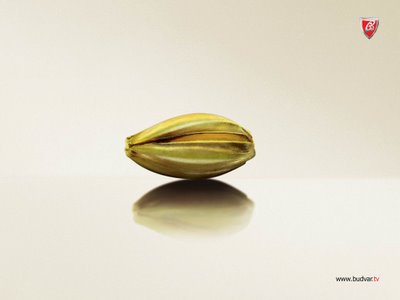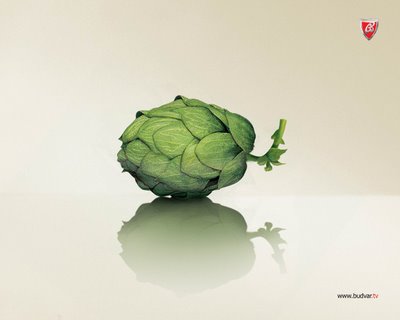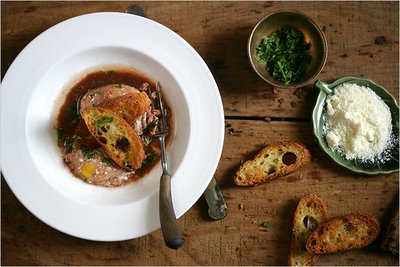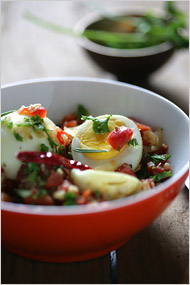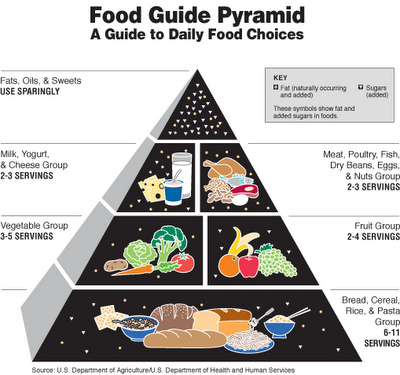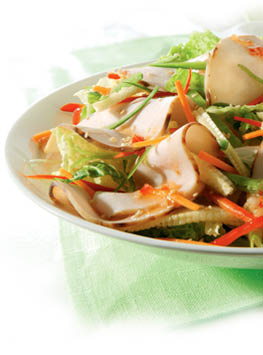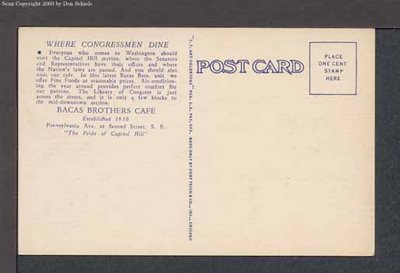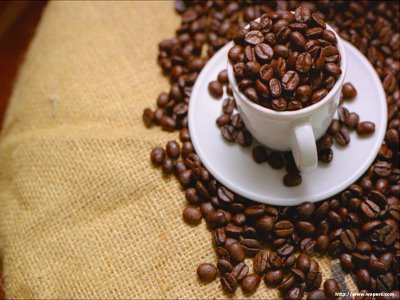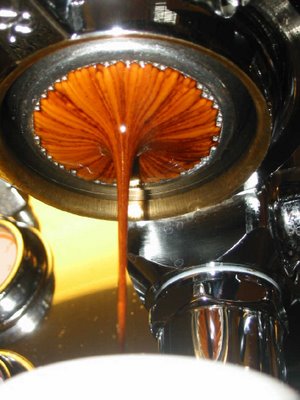17/11/06
14/11/06
8/10/06
Φρούτο δροσερό επιδόρπιο GOURMET
• ένα κιλό ελληνικό στραγγιστό γιαούρτι με όλα τα λιπαρά!
• δυο μήλα GOLDEN JONAS
• ένα ώριμο Μάνγκο
• ένα φακελάκι Σαφράνι, ( Ζαφορά ή Κρόκο )
• δέκα κομμάτια κάρδαμο ή κακουλέ
• ένα φλιτζάνι ασπρισμένα και καβουρδισμένα αμύγδαλα
• ένα φλιτζάνι καθαρισμένα ανάλατα φιστίκια Αίγινας
• ένα φλιτζάνι ζάχαρη
• χτυπάμε το γιαούρτι και την μισή ζάχαρη μέχρι να αφρατέψουν και τα βάζουμε στο ψυγείο.
• σε ένα μπρίκι με λίγο νερό ρίχνουμε το Σαφράνι και τα κάρδαμα να πάρουν μια βράση τα κατεβάζουμε από το μάτι και τα αφήνουμε να κρυώσουν.
• Σε ένα τηγάνι ρίχνουμε το Μάνγκο και τα μήλα κομμένα σε μικρά κομμάτια, την υπόλοιπη ζάχαρη και 2 κουταλιές της σούπας νερό με κάρδαμα και σαφράνι και τα γκλασάρουμε για 15 λεπτά ή μέχρι να κάνουν ένα βαρύ σιρόπι.
• Βγάζουμε το γιαούρτι από το ψυγείο ρίχνουμε τους ξηρούς καρπούς και το μισό από το νερό με το σαφρανι και τα κάρδαμα και ξαναχτυπάμε για 2 λεπτά σε χαμηλή ταχύτητα.
• Σερβίρουμε σε ανοιχτό μπολ το γιαούρτι και από πάνω περιχύνουμε τα φρούτα και το σιρόπι
Καλή όρεξη
MAY THE FORCE BE WITH YOU
(Brexians lair)
by
brexians
στις
21:34
0
of you said:
![]()
6/10/06
Baked Savory Custard With Cheese
2 cups cream, half-and-half or milk
1 sprig thyme, optional
1 clove garlic, optional
3 eggs plus 2 yolksPinch cayenne
½ teaspoon salt
½ cup grated semihard cheese, like Gruyère, Comté or Emmenthal
½ cup grated Parmesan.
1. Put cream in a small pot with thyme and garlic, if you’re using them. Cook just until it begins to steam. Heat oven to 300 degrees and set a kettle of water to boil.
2. Put eggs, cayenne and salt in a medium bowl and whisk or beat until blended; stir in the cheese. Remove thyme and garlic from cream, then add cream gradually to egg mixture, whisking constantly. Pour mixture into a 1-quart dish or into 4 ramekins or custard cups.
3. Put dish or ramekins in a deep baking pan and pour boiling water in, to within about 1 inch of top of dish or ramekins. Bake until mixture is not quite set; it should jiggle a bit in middle. This will take about 30 minutes for ramekins and longer for baking dish; also, cream sets faster than milk. Serve warm, at room temperature, or cold within a few hours of baking.
MAY THE FORCE BE WITH YOU
Copyright © Demetrios the Traveler
(Brexians lair)
by
brexians
στις
20:32
0
of you said:
![]()
Eggs Poached in Red Wine
1. Put 3 or 4 tablespoons oil in a large skillet and turn heat to medium. Add garlic and cook, turning occasionally, until it just begins to colour. Lower heat a bit and add bread; sprinkle it with a little salt and pepper. Cook, turning once or twice, until bread is crusty and golden.
2. Meanwhile, heat wine in a saucepan, preferably one with sloping sides; add some salt. When wine boils, reduce heat to a low simmer. Carefully slip eggs in and cook, spooning wine over them, until whites are barely firm.
3. Scoop eggs into 2 or 4 bowls, along with some wine. Add a piece or two of bread to each bowl garnish with cheese and parsley, and serve.
by
brexians
στις
20:26
0
of you said:
![]()
Spicy Scrambled Eggs
1. Put butter or oil in a skillet, preferably non-stick and turn heat to medium-high. Add garlic, ginger, onions, chilli and a sprinkling of salt and pepper. Cook, stirring occasionally, until garlic begins to colour, about 3 minutes. Remove from heat and let cool for about 5 minutes.
2. Beat eggs lightly with a little more salt and pepper. Return pan to medium-high heat and add eggs. Stir occasionally, until curds begin to form, then remove from heat and stir to break up curds. Return to heat and repeat, stirring occasionally until mixture begins to clump. Cook and stir until eggs are creamy and thick but not dry: they will continue to cook under their own heat after you remove them from pan, so stop a moment short of your desired consistency.
3. Stir in parsley and serve immediately.
(Brexians lair)
by
brexians
στις
20:20
0
of you said:
![]()
Hard-Cooked Eggs in Tomato-Onion Sauce
3 tablespoons extra virgin olive oil
3 cups chopped tomatoes (canned are fine)
1. Put oil in a skillet and turn heat to medium. A minute or 2 later, add onions, garlic, chillies if you’re using them and herb.
Cook, stirring, for a minute or 2, then cover pan and turn heat to medium-low.Cook until onions are very soft but not brown, 10 to 15 minutes.
2. Meanwhile, put eggs in cold water to cover. Turn heat to medium-high, bring to a boil, then turn off heat and cover; set a timer for 9 minutes.
3. When onions are done, uncover and turn heat to medium-high. Add tomatoes, a pinch of salt and some pepper, and cook, stirring occasionally, until mixture bubbles. Cook for about 5 more minutes.
4. When eggs are done, put them in a bowl of ice water, then place under cold running water until they feel cool, then peel. When tomato sauce is ready, add eggs to it; cook an additional 5 minutes or so. Taste and adjust seasoning, garnish and serve hot.
HARD-COOKED EGGS IN SPICY TOMATO SAUCE:2nd version
(Brexians lair)
by
brexians
στις
20:14
0
of you said:
![]()
30/9/06
8 tips for eating well
These practical tips can help you make healthier choices. The two keys to a healthy diet are eating the right amount of food for how active you are and eating a range of foods to make sure you’re getting a balanced diet.A healthy balanced diet contains a variety of types of food, including lots of fruit, vegetables and starchy foods such as wholemeal bread and wholegrain cereals; some protein-rich foods such as meat, fish, eggs and lentils; and some dairy foods.
1. Base your meals on starchy foods
Starchy foods such as bread, cereals, rice, pasta and potatoes are a really important part of a healthy diet. Try to choose wholegrain varieties of starchy foods whenever you can. Starchy foods should make up about a third of the food we eat. They are a good source of energy and the main source of a range of nutrients in our diet. As well as starch, these foods contain fibre, calcium, iron and B vitamins.
Most of us should eat more starchy foods – try to include at least one starchy food with each of your main meals. So you could start the day with a wholegrain breakfast cereal, have a sandwich for lunch, and potatoes, pasta or rice with your evening meal.Some people think starchy foods are fattening, but gram for gram they contain less than half the calories of fat. You just need to watch the fats you add when cooking and serving these foods, because this is what increases the calorie content.
Why choose whole grain foods?
Wholegrain foods contain more fibre and other nutrients than white or refined starchy foods.We also digest wholegrain foods more slowly so they can help make us feel full for longer.Whole grain foods include:
Whole meal and wholegrain bread, pitta and chapatti
Whole wheat pasta and brown rice
Whole grain breakfast cereals
2. Eat lots of fruit and veg
Most people know we should be eating more fruit and veg. But most of us still aren't eating enough. Try to eat at least 5 portions of a variety of fruit and veg every day. It might be easier than you think. You could try adding up your portions during the day.For example, you could have:
a glass of juice and a sliced banana with your cereal at breakfast
a side salad at lunch
a pear as an afternoon snack
a portion of peas or other vegetables with your evening meal
You can choose from fresh, frozen, tinned, dried or juiced, but remember potatoes count as a starchy food, not as portions of fruit and veg.
3. Eat more fish
Most of us should be eating more fish – including a portion of oily fish each week. It's an excellent source of protein and contains many vitamins and minerals.Aim for at least two portions of fish a week, including a portion of oily fish. You can choose from fresh, frozen or canned – but remember that canned and smoked fish can be high in salt.
What are oily fish?
Some fish are called oily fish because they are rich in certain types of fats, called omega 3 fatty acids, which can help keep our hearts healthy.
How much oily fish?
Although most of us should be eating more oily fish, women who might have a baby one day should have a maximum of 2 portions of oily fish a week (a portion is about 140g). And 4 is the recommended maximum number of portions for other adults.Examples of oily fishSalmon, mackerel, trout, herring, fresh tuna, sardines, pilchards, eelExamples of white or non-oily fishCod, haddock, plaice, coley, tinned tuna, skate, hakeShark, swordfish and marlin Don’t have more than one portion a week of these types of fish. This is because of the high levels of mercury in these fish.Anyone who regularly eats a lot of fish should try and choose as wide a variety as possible.For more information on fish and for advice – including recommended limits – for children, women who are pregnant, breastfeeding or trying for a baby, see the link below.
4. Cut down on saturated fat and sugar
Fats
To stay healthy we need some fat in our diets. What is important is the kind of fat we are eating. There are two main types of fat:
saturated fat – having too much can increase the amount of cholesterol in the blood, which increases the chance of developing heart disease
unsaturated fat – having unsaturated fat instead of saturated fat lowers blood cholesterol
Try to cut down on food that is high in saturated fat and have foods that are rich in unsaturated fat instead, such as vegetable oils (including sunflower, rapeseed and olive oil), oily fish, avocados, nuts and seeds.
Foods high in saturated fat
Try to eat these sorts of foods less often or in small amounts:
meat pies, sausages, meat with visible white fat
hard cheese
butter and lard
pastry
cakes and biscuits
cream, soured cream
coconut oil, coconut cream or palm oil
For a healthy choice, use just a small amount of vegetable oil or a reduced-fat spread instead of butter, lard or ghee. And when you are having meat, try to choose lean cuts and cut off any visible fat.
How do I know if a food is high in fat?
Look at the label to see how much fat a food contains. Generally the label will say how many grams (g) of fat there are in 100g of the food.Some foods also give a figure for saturated fat, or ‘saturates’. Use the following as a guide to what is a lot and what is a little fat per 100g of food.This is A LOT of fat 20g fat or more per 100g5g saturates or more per 100gThis is A LITTLE fat3g fat or less per 100g1g saturates or less per 100gIf the amount of total fat is between 3g and 20g per 100g, this is a moderate amount of total fat. Between 1g and 5g of saturates is a moderate amount of saturated fat.Try to choose more foods that only contain a little fat (3g fat or less per 100g) and cut down on foods that contain a lot of fat (20g fat or more per 100g).
Sugar
Most people iare eating too much sugar. We should all be trying to eat fewer foods containing added sugar, such as sweets, cakes and biscuits, and drinking fewer sugary soft and fizzy drinks.Having sugary foods and drinks too often can cause tooth decay, especially if you have them between meals. Many foods that contain added sugar can also be high in calories so cutting down could help you control your weight.
How do I know if a food is high in added sugar?
Take a look at the label. The ingredients list always starts with the biggest ingredient first. But watch out for other words used to describe added sugar, such as sucrose, glucose, fructose, maltose, hydrolysed starch and invert sugar, corn syrup and honey. If you see one of these near the top of the list, you know the food is likely to be high in added sugars.Another way to get an idea of how much sugar is in a food is to have a look for the 'Carbohydrates (of which sugars)' figure on the label. But this figure can't tell you how much is from added sugars, which is the type we should try to cut down on.10g sugars or more per 100g is A LOT of sugar2g sugars or less per 100g is A LITTLE sugarIf the amount of sugars is between 2g and 10g per 100g, this is a moderate amount.Sometimes you will only see a figure for total 'Carbohydrates', not for 'Carbohydrates (of which sugars)', which means the figure also includes the carbohydrate from starchy foods.
5. Try to eat less salt – no more than 6g a day
Lots of people think they don't eat much salt, especially if they don't add it to their food. But don't be so sure! Every day, 85% men and 69% women eat too much salt.
Adults – and children over 11 – should have no more than 6g salt a day. Younger children should have even less.Three-quarters (75%) of the salt we eat comes from processed food, such as some breakfast cereals, soups, sauces, bread, biscuits and ready meals. So you could easily be eating too much salt without realising it.Eating too much salt can raise your blood pressure. And people with high blood pressure are three times more likely to develop heart disease or have a stroke than people with normal blood pressure.
How do I know if a food is high in salt?
Salt is often listed as sodium on food labels. Salt = sodium x 2.5.Use the following as a guide to what is a lot and what is a little salt (or sodium) per 100g food.This is A LOT of salt1.25g salt or more per 100g0.5g sodium or more per 100gThis is A LITTLE salt0.25g salt or less per 100g0.1g sodium or less per 100gTry to choose foods that are low in salt (0.25g salt or less per 100g).
6. Get active and try to be a healthy weight
It's not a good idea to be either underweight or overweight. Being overweight can lead to health conditions such as heart disease, high blood pressure or diabetes. Being underweight could also affect your health. Check if you are the right weight for your height using the link below.If you’re worried about your weight, ask your GP or a dietitian for advice. But if you think you just need to lose a little weight, the main things to remember are:
only eat as much food as you need
make healthy choices – it’s a good idea to choose low-fat and low-sugar varieties, eat plenty of fruit and veg and wholegrains
get more active
It’s also important to eat a variety of types of food so you get all the nutrients your body needs.Physical activity is a good way of using up extra calories, and helps control our weight. But this doesn’t mean you need to join a gym. Just try to get active every day and build up the amount you do. For example, you could try to fit in as much walking as you can into your daily routine. Try to walk at a good pace.Whenever we eat more than our body needs, we put on weight. This is because we store any energy we don't use up – usually as fat. Even small amounts of extra energy each day can lead to weight gain.But crash diets aren't good for your health and they don't work in the longer term. The way to reach a healthy weight – and stay there – is to change your lifestyle gradually. Aim to lose about 0.5 to 1kg (about 1 to 2lbs) a week, until you reach a healthy weight for your height.
7. Drink plenty of water
We should be drinking about 6 to 8 glasses (1.2 litres) of water, or other fluids, every day to stop us getting dehydrated. When the weather is warm or when we get active, our bodies need more than this. But avoid drinking soft and fizzy drinks that are high in added sugar.
Alcohol
There is nothing wrong with the occasional drink. But drinking too much can cause problems. Alcohol is also high in calories, so cutting down could help you control your weight.Women can drink up to 2 to 3 units of alcohol a day and men up to 3 to 4 units a day, without significant risk to their health.A unit is half a pint of standard strength (3 to 5% ABV) beer, lager or cider, or a pub measure of spirit. A glass of wine is about 2 units and alcopops are about 1.5 units.For good health, it's a good idea to spread your drinking throughout the week and avoid binge drinking. Drinking heavily over a long period of time can damage the liver.
8. Don’t skip breakfast
Breakfast can help give us the energy we need to face the day, as well as some of the vitamins and minerals we need for good health.Some people skip breakfast because they think it will help them lose weight. But missing meals doesn't help us lose weight and it isn't good for us, because we can miss out on essential nutrients. Research shows that eating breakfast can actually help people control their weight. This is probably because when we don't have breakfast we're more likely to get hungry before lunch and snack on foods that are high in fat and sugar, such as biscuits, doughnuts or pastries.So why not go for a bowl of wholegrain cereal with some sliced banana and a glass of fruit juice for a healthy start to the day?
(Brexians lair)
by
brexians
στις
19:26
0
of you said:
![]()
26/9/06
A Touch of Greece, and a Spatter of Grease
ΤΟ ΕΛΛΗΝΙΚΟ ΔΑΙΜΟΝΙΟ ΣΤΗΝ ΑΜΕΡΙΚΑΝΙΚΗ ΠΡΩΤΕΥΟΥΣΑ
When Homer Bacas moved his family to the Virginia suburbs in 1960, he bought a brick rambler on an acre in Fairfax County. It was on a dirt road with a hand-lettered sign that read "Atheans Road."
He promptly went to the courthouse and got county officials to agree to give his street the name "Athens Road." The faulty spelling of an early land surveyor was corrected, but it was also Bacas's sly way of putting his Greek heritage on the county map.
His father, Angelos Bacas (pronounced BACK-us), came to Washington as a young man and eventually brought three brothers with him. They ran a series of restaurants across the city, including the Bacas Bros. Cafe on Capitol Hill.
In 1919, Angelos Bacas opened the evocatively named P.O. Visible Lunch on North Capitol Street. The "P.O." came from its location near the main post office and the Government Printing Office; "Visible Lunch" referred to the glass-front cases that allowed customers to watch food being prepared in one of the city's first cafeterias.
It was part of a quainter, more relaxed Washington that was never forgotten by Homer Angelos Bacas, who died Sept. 9 of a stroke at 82.
An affable man with a ready quip and an inability to sit still -- "Do something, even if it's wrong," he liked to say -- Bacas recalled a city of long-vanished Jewish, Irish, Italian and Greek enclaves. He rode streetcars all over town for a nickel, and the public school system was one of the best in the country.
The first home he could remember was at Eighth and M streets SE in Washington, and one of his earliest memories was of aviator Charles Lindbergh as he emerged from the gates of the Washington Navy Yard across the street. For a year or two, Bacas's parents ran a hotel in Cumberland, Md., until a fire burned the mountaintop inn to the ground. The family then moved back to Washington.
As a young man, Bacas and his boyhood friend Bowie Kuhn, who later became the commissioner of Major League Baseball, helped operate the scoreboard during Washington Senators games at the old Griffith Stadium.
When Bacas graduated from Roosevelt High School, the principal summoned him and his father to a meeting, concerned that the teenager was getting in with the wrong crowd. The principal and Bacas's father decided to send him to Virginia Tech, far from the temptations of the city.
Father and son rode the train to Blacksburg, and once they got there, Bacas began to panic.
"What am I going to do for money?" he asked.
"Get a job," his father said, boarding the train back to Washington.
After two years of waiting tables and studying engineering at "VPI" -- Bacas insisted on using the old name of Virginia Polytechnic Institute -- he enlisted in the Navy during World War II. After the war, he returned to a bustling Washington and worked in the family's restaurants, becoming a skilled short-order cook. He would make breakfast for his family throughout his life.
In 1949, he married Estelle "Chickie" Mandris and began to look for a way to make his own way in the world. He began an extermination business, working primarily in restaurants, then in 1960 opened the Bacas Co. Real Estate, a Fairfax County brokerage firm that he ran until he retired four years ago. He focused on commercial properties and helped develop the Jermantown Square shopping center in Fairfax City.
As he and his wife raised their four daughters, they watched their community change from its early rural character -- his first neighbors raised horses and goats -- to a dense suburb.
The Bacases brought a touch of Greece to Athens Road every spring with a Greek Easter celebration for the extended family, complete with roasted lamb, eggs and all the traditional trimmings.
In 1972, Bacas and 22 of his relatives made a pilgrimage to Greece. They visited three of the four villages that his grandparents had come from, but as they approached the fourth -- his mother's home town -- she stopped and refused to go on. She preferred to remember the village she knew as a child, before time had wrought its inevitable change.
Six years ago, Bacas suffered a stroke that affected his speech, and his wife died in 2004. But until the end, he never lost his storytelling gift or his sunny view of life.
"My dad truly believed that everything he had was the best," said his eldest daughter, Diane Hoffman. "He was never jealous and never pined for what other people had."
For the past two years, he had a kitchen in his apartment at a retirement home. Each morning, he got up to make eggs for breakfast, just the way he had learned at the P.O. Visible Lunch so long ago.
(Brexians lair)
18/9/06
ΣΥΚΑ ΜΕ ΜΑΝΟΥΡΙ ΚΑΙ ΚΡΑΣΙ
12 ΦΡΕΣΚΑ ΣΥΚΑ
1 ΠΟΤΗΡΙ ΚΟΚΚΙΝΟ ΚΡΑΣΙ
250 γραμ. ΜΑΝΟΥΡΙ
300 γραμ. ΖΑΧΑΡΙ
ΔΥΟΣΜΟ ΚΑΙ ΣΤΑΦΥΛΙΑ ΓΙΑ ΓΑΡΝΙΤΟΥΡΑ
Σε ένα μεγάλο και βαθύ τηγάνι, βαλτε τον γλυκάνισο, την κανέλα, το κρασί και τα σύκα.
Αφήστε τα να πάρουν μια βράση, βγάλτε το τηγάνι και αφήστε το στην άκρη για 15 λεπτά. Βγάλτε άπο μέσα τα σύκα, προσθέστε την ζάχαρη και φτιάξτε ένα βαρύ σιρόπι.
Κόψτε τα σύκα στη μέση, βάλτε σε κάθε 1/2 σύκο μια λεπτή φέτα μανούρι και στολίστε μια πιατέλα.
MAY THE FORCE BE WITH YOU
by
brexians
στις
22:23
2
of you said:
![]()
17/9/06
History of Coffee no 2
(Brexians lair)
by
brexians
στις
17:42
0
of you said:
![]()
Learn About Coffee
Brewing Tips
Everyone has their own way of personalizing coffee, but here are a few basic tips for brewing coffee to help get you started:
Great brewed flavor begins with fresh coffee. When using whole beans, try to grind immediately before brewing coffee. Protect the freshness of whole bean and ground coffee beans by storing in an airtight container.
When brewing coffee, always start with fresh, cold water. Since brewed coffee is over 98% water, the quality of water affects flavor. Use bottled or filtered water if tap water is not of high quality.
The proportion of coffee to water is very important. We recommend using two tablespoons for every six ounces of water to extract the full flavor of our coffees. If your brewed coffee tastes too strong, add small amounts of hot water to taste. Using too little can result in over-extraction of the coffee and bitterness in the cup. Using a coffee scoop will ensure your accuracy.
Check the water temperature of your coffee brewing equipment. Ideal brew temperature of water is 195-205 degrees Fahrenheit. When using a french press, or plunge pot, water should be heated in a kettle and poured just off-boil. Boiling water should never come in contact with the grounds.
Coffee is best if served immediately after brewing, and will retain its peak flavor for up to 20 minutes on the warmer. We recommend you transfer your brewed coffee to a thermal carafe to hold for a longer period of time.
Don’t forget to take care of your equipment! A clean coffee brewer is critical to great tasting coffee. Periodically, use a mild detergent or baking soda to remove build-up, film and oil.
(Brexians lair)
by
brexians
στις
17:22
0
of you said:
![]()





